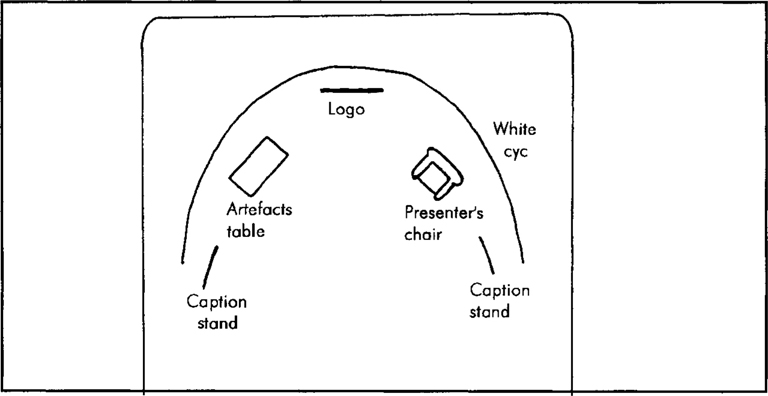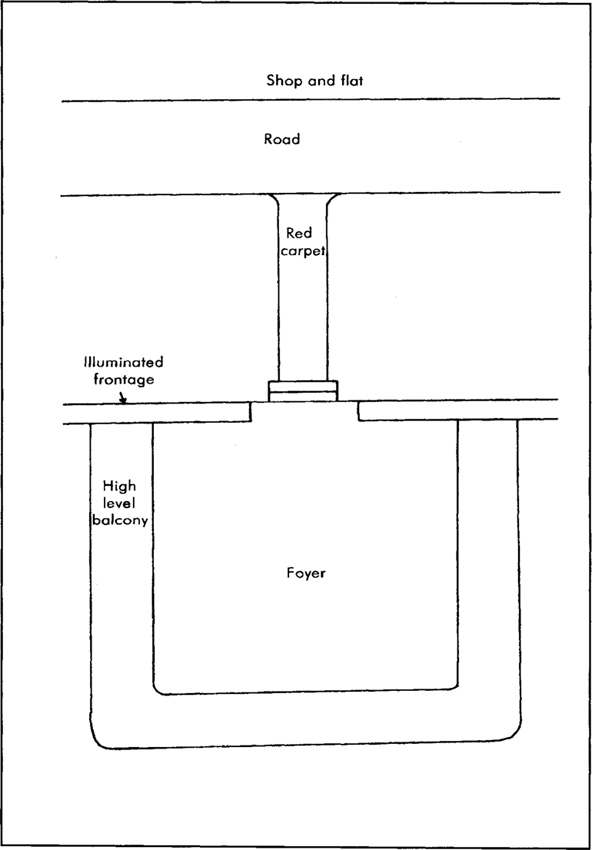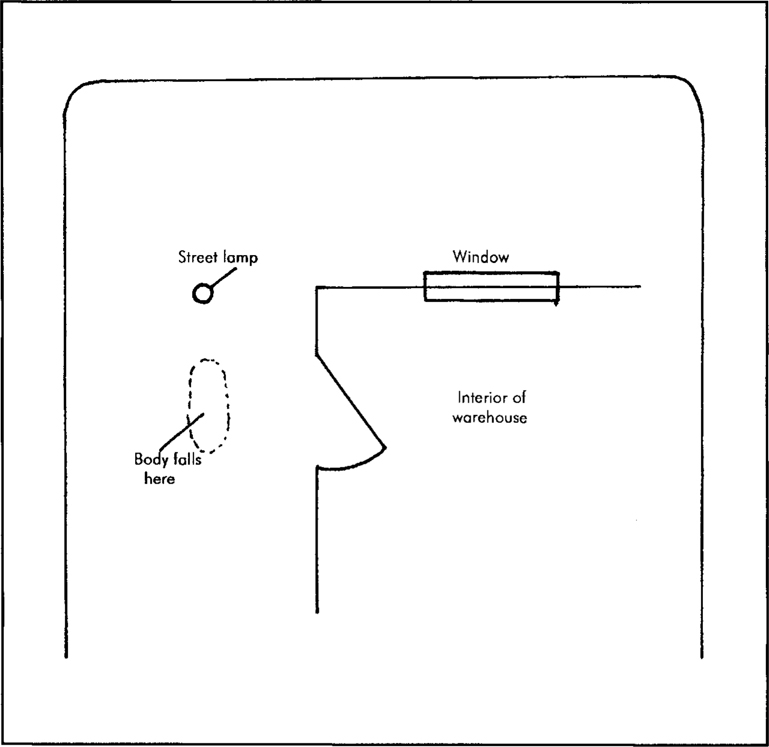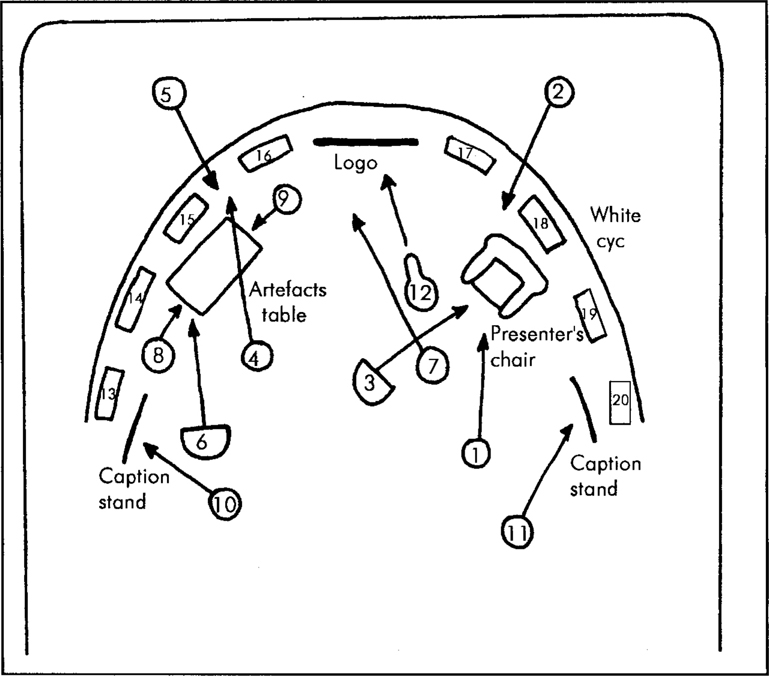15 Your turn now!
In the next few pages we invite you to try out your lighting skills by designing your own lighting for the scenes specified. There is a brief description of the scene and what the director wants to be lit, and also be an indication of what lighting equipment may be available, and any special factors to be allowed for.
With each exercise is a diagrammatic plan of the scene, showing camera positions, performer positions, the position of any ambient lighting and so on.
Try to think out how you would approach the lighting of the scene. You can do this as a simply imagined exercise, or you might like to pencil your solution onto the plan, or perhaps you want to build up the scene and try to light it for real!
Once you have done your best, look at the suggestions on how we might do it, which follow after Exercise 4. We should stress here that there is never only one correct answer, least of all the one we suggest. You may well come up with a better way of solving the problem. On the ‘Possible Solution’ pages, there is room for you to make your own notes.
Exercise 1 Location interior
For a documentary the director wants an interview with the manager of a local water plant in his office which overlooks the works. The main part of it will be shot with him at his desk in front of the window. He insists he can only make his office available for an hour and doesn’t want anything moved in it. The director plans to get MCUs and MSs of him at his desk, reverse angle MCUs of the interviewer for ‘noddies’, an LS from the door of the interviewer entering the office and being greeted, and possibly some shots showing the manager standing at the window indicating parts of the plant.
The window faces south, and the weather is forecast to be overcast. There are plenty of power points in the room and the corridor outside it. The walls of the office are painted cream and the ceiling is white. The window has a venetian blind. The desk has a glass top. The room has fluorescent lighting, with a small tungsten desk lamp.
Equipment available includes:
• 2 x 2 kW ‘blonde’ lanterns, with stands
• 3 x 800 W ‘redhead’ lanterns, with stands and gaffer clamps
• Plenty of blue daylight correction filter
• Some amber tungsten correction filter
• A little diffusion material.
Exercise 1 Set – location interior

Exercise 2 Studio information programme
A studio based information programme, with one presenter, is being recorded. The elements of it include the presenter sitting in a comfortable chair, talking to camera and describing video clips, the presenter walking across to another set, which has a table of artefacts, close-up shots of those artefacts, photographs and diagrammatic captions, on two stands, and a large programme logo on the back wall of the set.
The director wants the presenter to be seen first in silhouette, with the logo visible, in long shot. A similar shot will be used at the end under the credits. The captions are needed all through the programme.
Equipment available includes:
• 8 x 2 kW fresnel spots
• 2 x 1 kW fresnel spots
• 6 x 1.25/2.5 kW floods
• 2 x 2 kW profile spots
• 32 cells of cyclorama lights (500 W each) in clusters of four [All the above are riggable anywhere, at any height.]
• A 2-preset 24 channel (2.5 kW capacity per channel) dimming system
• No floor stands
Exercise 2 Set – studio information programme

Exercise 3 Location exterior
A ceremony is about to take place! The local cinema has arranged for a splash preview of a famous film, together with guest appearances by celebrity stars of the film. The local cable TV station want coverage of it. The stars will arrive by limousine at 8 pm and walk up the red carpet to the entrance of the cinema. Inside they will be greeted by the cinema manager and the mayor. Inside the cinema there is a large foyer, with an overlooking balcony (closed to public and guests). Opposite the cinema, across the road, access is possible to a shop and the flat above it. There is expected to be a large crowd outside the cinema, but they will be behind barriers. There will also be a (fairly famous) interviewer who is detailed to ask questions of the stars as they leave their cars.
The event is to be covered by four camera units. The two outside will have microwave links back to a control van. They will deal with the long shot of the cinema front (from the shop opposite) and the ‘out-of-car’ interviews. Inside the cinema will be two more, one down in the foyer to grab shots of the great and good as they mingle, the other on the balcony to get long shots. There is plenty of power available in the cinema and in the shop opposite, but the local council’s health inspector has insisted on no mains powered lights at ground level outside the building and is concerned about safety aspects inside the cinema foyer.
By the way, the cinema has illumination of its frontage, which will be on, and the event is taking place in February. The weather forecast is for dry, but cold weather. The local cable station, running a volunteer programme, has plenty of people available to crew this event.
The equipment available has not been finalized since the station’s lighting director has been taken ill. You have been asked to take over, 24 hours ahead of the programme, and you have been told, that within reason, you can hire whatever you need.
What would you order?
Exercise 3 Exterior location

Exercise 4 Drama in studio
A suspicious character leans against a lamppost outside a doorway. Inside the weary manager checks the last couple of cases in the corner of the dingy warehouse then puts his clipboard on top of one of them, scratches his forehead, and moves towards the door, feeling in his pocket for his keys. As he opens the door the character lurking outside melts further into the shadows, and the bright stream of light cascades across the pathway.
The manager – outside the door by now – reaches inside, switches off the light, closes the door and locks it. He steps across the pavement, but before he can go a couple of steps he is brutally struck down by the suspicious character who steals his key and quietly re-opens the door. The manager is left for dead as the thief strikes a match to orient himself in the warehouse. Rapidly the light from the match dies out, but by now the thief’s eyes have grown accustomed to the moonlight streaming in through the window on the back wall and he can see his way to the top case. Too late he realizes the police have arrived, and as they burst in through the door his look is one of desperation.
Don’t worry – don’t have nightmares, it is studio drama. It is also, to a large extent, a story told by light, so how would you do it?
You are the lighting director for this melodrama and you have to provide good visible, but dramatic, shots of the story for the director. The set is as shown in the plan opposite – you have the usual range of studio luminaires and fittings to use and a dimmer system with memory. There is a moderate budget for additional lighting equipment should you need it.
Exercise 4 Studio set

Exercise 1 Possible solution
Perhaps the main difficulty here is the imposition of the window. It will be a very bright light source. Thankfully the weather is due to be overcast so we can assume fairly constant colour temperature. Because the director may require a shot of the manager looking out of the window we cannot simply over-expose the outside to bring up the relative brightness of the interior. Nor can we close the venetian blind. We must therefore lift the interior brightness.
A heavily diffused ‘blonde’ shining from by the filing cabinets may help to lift the overall ambient in the room to a sufficient level that it can balance the daylight. If this is not enough a second ‘blonde’ bouncing off the ceiling may help. The pale walls should help to diffuse and maintain the level, but may be tricky for colour.
A ‘redhead’, shining from between the camera and interviewer, or from the right of the interviewer could work as a key, on top of the increased ambient achieved by the ‘blonde(s)’. For the reverse shots it would have to be removed.
All the lanterns would have be corrected back with blue filter, or, less preferable because of the requirement to see out of the window, the window could be corrected with amber, and the lanterns left open.
The glass desk top could be problematic, but as long as we don’t use an additional back light behind it is probably one the camera operator will have to deal with. The desk lamp, especially if the manager has white papers on his desk, could provide some useful contrast control under his chin and provide a local source of brightness which will help balance the excessive brightness of the window in the shot. Whether or not to colour correct it is a matter of judgment depending on the look of the picture – it could be quite nice set at ‘wrong’ colour giving a warmth to the desk area.
• What would you do if you didn’t have (or couldn’t power up) the ‘blondes’?
• What would you do if the weather forecast was for sunshine and showers?
• What would you do if the interview was to be shot at night?
Exercise 1 Possible solution

Notes
Exercise 2 Possible solution
The presenter in her chair could be lit by 2 kW fresnel spots as back and key (1 and 2) and a flood as fill (3). For the silhouette the fill and key would be reduced in level. In the position behind the table again 2 kW fresnels (4 and 5) could be used, but carefully barndoored down to avoid spill onto the table itself. It is possible that the fill for the seated position may also cover this area – if not a similar one (6) could be used.
The walk could be adequately covered by the soft light from the fills, if it is reasonably quick, and seen only in long shot. Otherwise use an additional key – again a 2 kW fresnel (7). Care should be taken in this case to accurately barndoor the beams of the three keys down so that they don’t overlap, or leave black holes. All three keys should be steep enough to avoid spill onto the cyclorama.
The objects on the table could look very good given edge lighting from each end of the table. This could be adequately done by the two 1 kW fresnels (8 and 9). The caption stands need separate luminaires – a couple of 2 kW fresnels would do (10 and 11). Again care should be taken to avoid unwanted spill from these. The logo can be lit by a single spot. A 2 kW spot will do and the profile type has the advantage of being sharply controllable at the edge.
Finally the cyclorama can be lit by the 32 cells of cyc lights, patched in groups. Normally these are coloured up red, green, blue and open white, patched so that each colour is on a separate dimmer (or dimmers). It is then possible to blend the colours to achieve a wash of any desired colour (13–20).
Exercise 2 Possible solution

Notes
Exercise 3 Possible solution
This is quite a challenge, especially as there are going to be lots of people about and it is a ‘one chance’ shoot. Actually though it is quite straightforward. The good news is that because of the nature of the event, simply getting well illuminated images will suffice; we do not need to worry about the niceties of three point, modelling, contrast control, etc. Because it is February (at 8 pm) we have no intrusive daylight to worry about and because the weather is forecast to be dry, problems of rain into hot luminaires should not arise. There is a little worry about the council’s health and safety inspector though, so we should be careful not only to be safe, but to be seen to be safe.
Deal with outside shots first. The frontage will be bright but with badly distributed light (mostly on signboards, etc.). We would like a wash over the whole of it so a couple (maybe one if it’s big) of luminaires in the flat above the shop opposite would be helpful. The temptation here is to go for something like a couple of HMI 1200 W spots, which would give a huge light output, but if they are not available two ‘blondes’ might do the job.
The ‘out-of-car’ interviews grabbed by the famous interviewer obviously need highly mobile lighting, so battery-powered camera top lights are essential here. They could be usefully added to by separate hand-held sun gun’ lights operated by some of the many spare crew.
Inside the health inspector would be happy if there were no luminaires anywhere in the public areas, so putting them on the balcony seems a good idea. This also serves our purpose, of getting them well out of the way of possible knocking over by the throng. As different cameras are covering inside and outside shots we don’t have to worry about lights shining into the lens of cameras coming through the door so putting a 2 kW ‘blonde’ on each corner of the balcony should give us good coverage. To avoid possible crossed shadows it might be worth diffusing the luminaires on one side.
Exercise 3 Possible solution

Notes:
Exercise 4 Possible solution
The interesting challenge of this is that there is a great deal of atmospheric lighting required, but with next to no chance of standard three-point lighting. It needs to be dealt with stage by stage.
The first thing to think about is our suspicious character leaning against a lamppost.
The crucial clue is the lamppost. Think of how light falls from streetlights – pools of localized, vertical light. So what we need here is a single spot shining directly down onto our character. Whilst it is quite acceptable for the streets to look dark at night, we may wish to give our cameras the chance to pick up some details when the character is first seen, so a little soft light wash added on to the spot may be useful. This light could creep down as we become more used to him being there.
Inside the manager is working under artificial lighting, so again we would expect its shadows to be nearly vertical. Whilst the overall ambience is higher than out on the dark street, it still doesn’t crawl very far up the walls and is very localized. Maybe some small amount of soft light might be helpful to lift it.
When he opens the door the stream of light from inside may well need its own spot, at low height, shining horizontally through the door opening.
Once he is outside, there is a special requirement of the lighting to emphasize his stricken body when it falls, so a special spot for this is necessary, to be subtly faded up to a low level as he falls. Otherwise it is a repeat of the first scene – use of illuminating soft dependent on the needs of the story.
Inside the building, the thief striking a match is purely a practical (done by the actor) but it gives us the chance to cheat in a little ambient soft lighting to see what happens. The moonlight is dead simple. We think of it as blue, although it isn’t particularly, and when visible it is very hard. If it happens to cast a shadow of the window frame (gobo in a profile spot) even better.
The approaching police car is a rhythmically flashing primary blue light outside the window, mobile if possible. Thought now needs to be given to the timing of the changeovers, and luckily we have a memory desk which will greatly simplify the accurate repeat of them. The creep down of the exterior soft light (to see details of the thief) would be a 30 second slow fade. The door opening has a luminaire switched on (a zero time fade), followed shortly by it (and the interior lighting set-up) switching off. The spot for the fallen manager needs to come on (but not very bright) as he falls, so that is also quick, maybe 1½ seconds.
The time of the match burning can allow us to creep up enough soft light to see what he’s up to inside (maybe 10 seconds).
Exercise 4 Possible solution

Notes:
